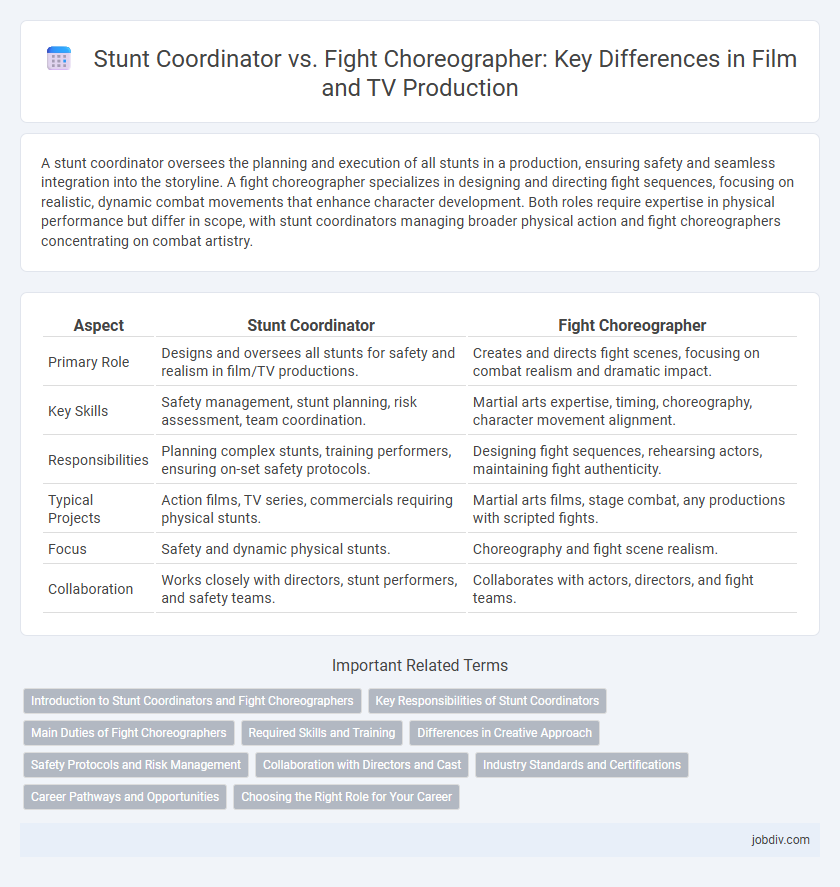A stunt coordinator oversees the planning and execution of all stunts in a production, ensuring safety and seamless integration into the storyline. A fight choreographer specializes in designing and directing fight sequences, focusing on realistic, dynamic combat movements that enhance character development. Both roles require expertise in physical performance but differ in scope, with stunt coordinators managing broader physical action and fight choreographers concentrating on combat artistry.
Table of Comparison
| Aspect | Stunt Coordinator | Fight Choreographer |
|---|---|---|
| Primary Role | Designs and oversees all stunts for safety and realism in film/TV productions. | Creates and directs fight scenes, focusing on combat realism and dramatic impact. |
| Key Skills | Safety management, stunt planning, risk assessment, team coordination. | Martial arts expertise, timing, choreography, character movement alignment. |
| Responsibilities | Planning complex stunts, training performers, ensuring on-set safety protocols. | Designing fight sequences, rehearsing actors, maintaining fight authenticity. |
| Typical Projects | Action films, TV series, commercials requiring physical stunts. | Martial arts films, stage combat, any productions with scripted fights. |
| Focus | Safety and dynamic physical stunts. | Choreography and fight scene realism. |
| Collaboration | Works closely with directors, stunt performers, and safety teams. | Collaborates with actors, directors, and fight teams. |
Introduction to Stunt Coordinators and Fight Choreographers
Stunt coordinators design and manage complex action sequences, ensuring safety while creating thrilling visuals for films and television. Fight choreographers specialize in crafting realistic and dynamic combat scenes, focusing on technique, timing, and actor performance to enhance storytelling. Both roles require extensive knowledge of physical movement, safety protocols, and collaboration with directors and actors to bring high-impact scenes to life.
Key Responsibilities of Stunt Coordinators
Stunt coordinators are responsible for designing, planning, and supervising all stunt sequences to ensure safety and realism on set. They collaborate with directors and stunt performers to create complex, high-risk actions while adhering to strict safety protocols and insurance requirements. Their role also includes training actors, coordinating with special effects teams, and managing the logistics of stunt setups to maintain production efficiency.
Main Duties of Fight Choreographers
Fight choreographers specialize in designing and rehearsing realistic, safe combat sequences for film, television, and theater productions. Their main duties include creating detailed fight scenes that enhance storytelling while ensuring the safety of performers through precise timing and controlled movements. They collaborate closely with actors, directors, and stunt coordinators to choreograph punches, kicks, weapon use, and falls that appear convincing on camera.
Required Skills and Training
Stunt coordinators require extensive knowledge of safety protocols, physical conditioning, and rigging techniques to design and supervise complex action sequences securely. Fight choreographers specialize in martial arts expertise, timing, and spatial awareness to create realistic and visually compelling combat scenes. Both roles demand rigorous training, strong communication skills, and a deep understanding of camera angles to ensure seamless integration into the entertainment production.
Differences in Creative Approach
Stunt coordinators design and manage complex action sequences emphasizing physical safety and realism, coordinating all stunt elements from planning to execution. Fight choreographers tailor combat scenes with a strong focus on character development and storytelling, crafting movements that convey emotion and narrative through precise timing and stylistic choices. Both roles require specialized expertise but differ fundamentally in their creative approach: stunt coordinators prioritize technical execution and risk management, while fight choreographers prioritize dramatic impact and character interaction.
Safety Protocols and Risk Management
Stunt coordinators implement comprehensive safety protocols, conducting risk assessments and ensuring all equipment meets industry standards to minimize hazards during complex sequences. Fight choreographers prioritize controlled movements and rehearsed timing to prevent injuries while maintaining dramatic authenticity. Both roles collaborate closely to balance creative vision with stringent risk management in high-impact entertainment productions.
Collaboration with Directors and Cast
Stunt coordinators and fight choreographers collaborate closely with directors and cast to ensure safety and authenticity during action sequences. Stunt coordinators focus on designing and supervising all physical stunts, while fight choreographers specialize in crafting realistic combat scenes aligned with the director's vision. Their combined expertise enhances the storytelling, creating seamless and engaging performances that are both visually compelling and safely executed.
Industry Standards and Certifications
Stunt Coordinators and Fight Choreographers both require specialized training and certifications to meet industry standards, with organizations like SAG-AFTRA providing guidelines and safety protocols essential for their roles. Stunt Coordinators typically hold certifications in stunt rigging, high falls, and vehicle stunt driving, ensuring comprehensive safety management on sets. Fight Choreographers often pursue certifications in martial arts, stage combat, and weapons handling accredited by institutions such as the Society of American Fight Directors (SAFD), emphasizing authenticity and performer safety.
Career Pathways and Opportunities
Stunt Coordinators typically advance from stunt performers, gaining expertise in designing and supervising complex action sequences for film and television, while Fight Choreographers often transition from martial arts or dance backgrounds, specializing in crafting realistic combat scenes. Both roles offer diverse career opportunities in Hollywood, theater, and live events, with growing demand driven by high-budget action productions and immersive experiences. Mastery in safety protocols, creativity, and collaboration with directors significantly enhances career growth in these dynamic entertainment fields.
Choosing the Right Role for Your Career
Choosing between a stunt coordinator and a fight choreographer depends on your career goals within the entertainment industry. A stunt coordinator manages overall stunt safety and logistics on set, often overseeing complex physical sequences, while a fight choreographer specializes in designing and teaching realistic combat sequences for actors. Understanding these roles and their specific skill sets helps professionals align their expertise with the demands of action-driven productions for career advancement.
Stunt Coordinator vs Fight Choreographer Infographic

 jobdiv.com
jobdiv.com